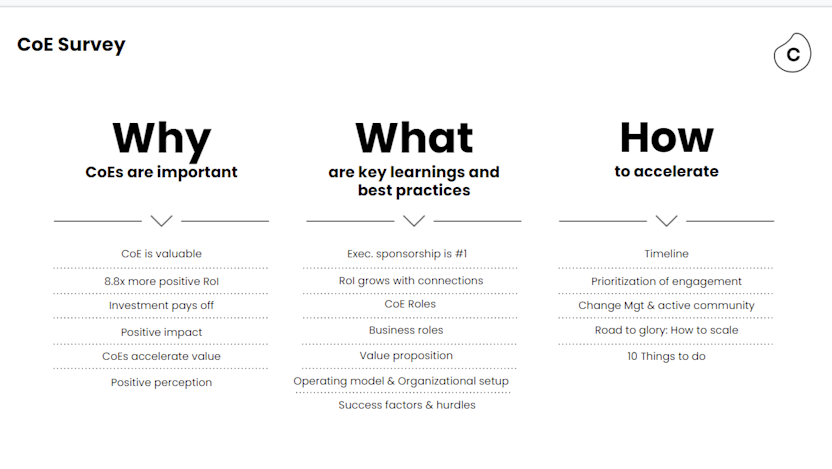
Why and how to scale Celonis Centers of Excellence (CoE) to grow value
Celonis customers with a Center of Excellence (CoE) and dedicated teams are 8.8x more likely to achieve positive returns on investments than customers without one, according to a survey. The data from the survey also provides a handy blueprint on why CoEs are important, what are best practices and how to accelerate the Celonis journey.
The survey, a joint collaboration between Celonis and the Fraunhofer FIT Institute released on the first day of World Tour 2022, addressed 500 Celonis customers and received 214 responses. Fraunhofer FIT Institute is the leading organization for applied research in Europe in respect to process-led organizations and digital transformation.
A Celonis CoE focuses on applying process mining and execution management across the business. More than 200 of Celonis’ customers have already established a CoE, representing more than $700 million total value realized by Celonis customers to date. The largest CoEs - which constitute the CeloCoE Champions League - have realized far beyond $10M value, support hundreds of users and dozens of processes. This League includes Companies like BMW, Bosch, Chevron, Mars, Siemens, Splunk to name a few.
This process mining muscle memory often pays off. According to the survey, 85% of customers who connected five or more processes said their investment in a CoE has paid off. And it has significant positive impact, e.g. on transparency (92%), identifying use cases (79%), saving costs (75%) and improving automation (57%).
Based on the data from Celonis and Fraunhofer FIT Institute, here's what are the key learnings and best practices when building out a CoE:
Make sure you have an executive sponsor. The No. 1 success factor for CoE success was having an executive sponsor, typically a C-level person in charge of the company, finances, technology or increasingly supply chain. Ninety-four percent of customers with a positive CoE ROI had an executive sponsor. The head of technology most often ran the CoE (26%), followed by chief operating officers and chief financial officers (both at 19%).
Have business buy-in. One of the big reasons an executive sponsor is critical is that you need someone to rally business units. Lack of business buy-in is a big hurdle to CoE success. There's no need to fret though: Once you notch a few process wins and derive value, business leaders start working with the CoE.
More on CoEs: Introducing CeloCoE, a champion's league for process mining, execution management and value acceleration | Celopeers discussion on CoEs |
Cover five processes or more and work with two to five departments. The most successful CoEs have connected a large number of processes and support multiple departments. In other words, scale matters and so does getting in the reps needed to achieve process excellence. Twenty-five percent of respondents said they established a CoE to accelerate their efforts after expanding to different departments and 21% created one after implementing one process.
Build the team. Beyond the obvious CoE lead common roles include:
Subject matter experts.
Data analyst.
Data engineer.
IT application owner.
Optional roles include:
Change manager.
Product owner.
Agile master.
Business value architect or external consultant.
Large organizations may have a CoE with 7 subject matter experts, 5 data analysts, 4 data engineers and 2 IT application owners. However, some organizations blend service providers with internal staff.

Find a champion. If the executive sponsor is Batman with the budget, you'll need a Robin to evangelize and promote process mining across the organization. Sometimes the executive sponsor is also the champion and other times there are hero project managers and transformation leaders to lead the charge.
Think through the CoE value proposition. Companies with the most successful CoEs tend to provide a technical platform, drive process mining as a service and execution management as a service. That platform will enable the business to leverage process best practices without technical hurdles. The CoE also provides user administration and governance, training, communication, support and value realization in some cases.
Pick an operating model. Two models of CoEs have emerged. A centralized model has one bundle for roles, responsibilities and activities. A hybrid CoE has one centralized CoE and more that are created based on business functions such as purchasing, procurement and accounts payable. Sixty-seven percent of survey respondents went with a centralized model.
Prioritize projects. CoEs have to channel requests and investments. Most CoEs prioritize projects based on company strategy and value realization potential.
Focus on community and change management. The majority of respondents said an active community of users and change management knowhow improved CoE ROI.
Expand. CoEs can scale globally with new use cases, units and departments as well as vertically into processes. This scaling process is also going to require training and development for staff within the CoE as well as outside of it to democratize process mining and execution management for business users. Both early stage and advanced CoE Celonis customers choose to expand vertically with new use cases and then go global.
For more on Celonis CoEs, best practices and data from customers see our white paper Accelerating Business Transformation with Process Mining Centers of Excellence (CoEs).
Download





